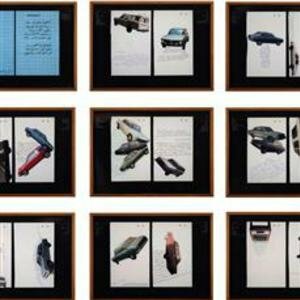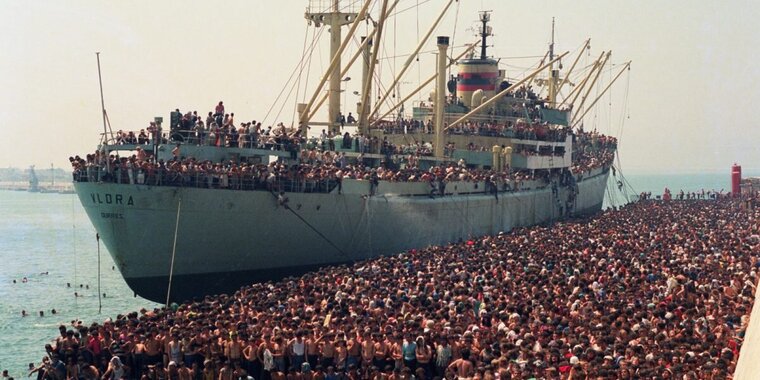


Last updated on Sat 16 September, 2017


Curated by Nicolò Degiorgis
16/09/2017 – 14/01/2018
The concepts of Heimat, the sense of belonging to a place, and homeland, interpreted in the light of current events in Europe, are the focus of the exhibition presented by Nicolò Degiorgis (Bolzano, 1985), Museion’s guest curator for 2017.
Hämatli & Patriæ tackles the theme using the symbolism in the Flemish painting of 1570 by Simon de Myle entitled Noah’s Ark on Mount Ararat, which depicts the landing rather than the departure of the ark, as is usually represented in artworks.
Taking its cue from this curious, almost grotesque, scene, the exhibition has been conceived as a large-scale mise-en-scene of the painting itself, interpreted in a contemporary key. Issues such as migration, nationalism, populism and identity are tackled in the form of dialogues inspired by the human figures, animals, objects and situations in the painting. The exhibition, which presents more than thirty works, including videos, sculptures, installations, photographs, drawings, artists’ books and documents, takes the form of an installation to explore, giving visitors food for thought regarding some of the events of recent years.
The main dialogue is that between Hämatli, the Germanic term which is the root of the word Heimat, and patriæ, the Latin word for nation and homeland. These concepts prompt 23 more dialogues, such as those between East and West, obverse and reverse, prey and predator, land and sea, border and horizon, pigs and the economy.
The central part of the exhibition space is dominated by a full-scale reproduction of a photograph by Luca Turi which has become part of our collective imagery on migration: the first landing in Italy of migrants from Albania on the ship Vlora in the port of Bari in 1991. The photograph is part of the dialogue between habitat and habitus, with the installation Romeno è Giulietta (Romanian is Juliet), 2015, by the artist Eugenio Tibaldi. The work takes the form of an opera on the tragic fate of Dimitri, a Romanian migrant who arrived in Italy on the Vlora: after ending up in Verona, working in a company making pandoro cakes, he died after a sex-change operation.
The impression created by the teeming crowds along the wharf in Bari shown in the image of the Vlora is continued by the massive jigsaw of coloured puzzle pieces that invades and “contaminates” the exhibition space, even climbing the walls. This is the modular sculpture Devi urlare in un bosco per sentirne l’eco, (You have to shout in a forest to hear the echo), 2017 by Luca Trevisani. This site-specific piece creates a living space, inhabited by the viewer and the other works in the exhibition. Trevisani’s work forges a dialogue with the drawings by the Swiss botanist Ernesto Schick of railway flora in Chiasso station. This location on the border between Italy and Switzerland boasts an incredible level of biodiversity, thanks to the particular soil on the man-made environment, and the presence of non-native seeds transported by the trains.
The 2015 video Volga by the Chechen artist Aslan Gaisumov tells the story of the artist’s journey, or rather flight, along with twenty other people, all crammed into a single car to escape Grozny during the first Chechen war. Setting up a dialogue between land and sea, Degiorgis pairs this work with another video, Kwassa Kwassa by the Danish collective Superflex, which depicts the work of a boat builder on the Comoro Islands off East Africa. These boats carry migrants to the nearby island of Mayotte, which is French territory and therefore European – a crossing that has already cost more than 10,000 lives.
Other groups of works explore elements that characterize the notions of homeland and nation, like the flag being ripped apart by two wolves in the video Homo Homini Lupus, 2011 by Filippo Berta, or those reduced to black and white graphic elements in the video Flash Flag / Pink Noise by Philipp Messner, from the Museion Collection. The work shows the 191 flags of the sovereign states recognized by the United Nations in such rapid succession that it is impossible to identity them. Then there are the flags stitched together to make up the unstable, sinister-looking installation Infinite Contradictions by the Romanian collective Apparatus 22.
Patria as homeland, and therefore the concept of roots, is the focus of the piece smash up by Andrea De Stefani, which interfaces with the notion of migration represented in the work Fussobjekte by Hans Winkler. The two cast iron forms reproduce the steps of Ötzi the Iceman, at the centre of a long-running possession dispute between Italy and Austria.
The concept of limit and border is taken to the air in the poetic work by Henrik Håkansson, Vertical swarm (Sturnus vulgaris) #01, which reflects on the delicate relationship between living beings, with one’s freedom ending where that of others begins. The stuffed birds in the Swedish artist’s installation were actually killed near an airport in Northern Italy – a common practice which is carried out to prevent disturbances to air traffic.
Airborne visions also characterize the work by Walid Raad Cotton under my Feet, 2007-2011 (Museion Collection), which consists in aerial views of various cities in the United States. In his attempt to remember the colour of the sky on 9/11, the Lebanese artist consulted several sources, which identified 96 different shades of blue, corresponding to the sections of the work on show.
The invitation to take a broader view that is implicit in many of the works is also reflected in the physical structure of the exhibition. After the first section of the show, visitors are plunged into darkness in a huge camera obscura which reflects an upside down image of the exhibition venue where they themselves were just moments before. It is only once we reach the end of the show, or come back to the start, that the similarities with the ancient painting are “revealed”, along with the dialogue pairings that inspired Nicolò Degiorgis.
The exhibition was preceded by five presentations of artists’ books in Museion, and in parallel in five sites in the local area which have a connection to the issues tackled in the books. The idea was to take art of the museum, into locations, communities and environments not normally associated with contemporary art. Since January 2017 the settings used have been: the Alexander Langer school, Bolzano; Villaggio Eni in Borca di Cadore (in collaboration with Dolomiti Contemporanee), Seminario Maggiore in Bressanone, the Plessi Museum (in collaboration with Autostrada del Brennero); and, from September 2017, Bolzano prison.
Featured artists:
Yuri Ancarani, Apparatus 22, Filippo Berta, Mohamed Bourouissa, Donna Conlon, Simon De Myle, Nicolò Degiorgis, Hannes Egger, Aslan Gaisumov, Henrik Håkansson, Petrit Halilaj, Laëtitia Badaut Haussmann, Paolo Icaro, Armin Linke, Marcello Maloberti, Philipp Messner, Giuseppe Penone, Walid Raad, Ernesto Schick, Giovanna Silva, Superflex, Eugenio Tibaldi, Luca Trevisani, Luca Turi, Danh Vo et al.
Join us in our endless discovery of modern and contemporary Arab art